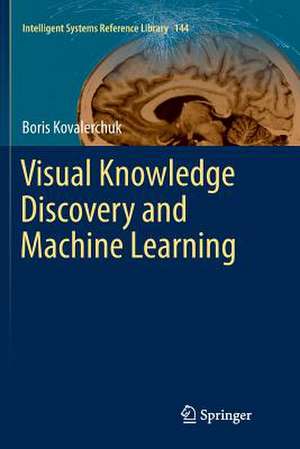Visual Knowledge Discovery and Machine Learning: Intelligent Systems Reference Library, cartea 144
Autor Boris Kovalerchuken Limba Engleză Paperback – 4 iun 2019
| Toate formatele și edițiile | Preț | Express |
|---|---|---|
| Paperback (1) | 1159.89 lei 6-8 săpt. | |
| Springer International Publishing – 4 iun 2019 | 1159.89 lei 6-8 săpt. | |
| Hardback (1) | 1166.34 lei 6-8 săpt. | |
| Springer International Publishing – 26 ian 2018 | 1166.34 lei 6-8 săpt. |
Din seria Intelligent Systems Reference Library
- 20%
 Preț: 1050.59 lei
Preț: 1050.59 lei - 20%
 Preț: 1157.60 lei
Preț: 1157.60 lei - 20%
 Preț: 648.44 lei
Preț: 648.44 lei - 20%
 Preț: 650.08 lei
Preț: 650.08 lei - 20%
 Preț: 1005.64 lei
Preț: 1005.64 lei - 5%
 Preț: 968.90 lei
Preț: 968.90 lei - 20%
 Preț: 1052.67 lei
Preț: 1052.67 lei - 20%
 Preț: 1171.46 lei
Preț: 1171.46 lei - 20%
 Preț: 1164.84 lei
Preț: 1164.84 lei - 20%
 Preț: 815.84 lei
Preț: 815.84 lei - 20%
 Preț: 989.96 lei
Preț: 989.96 lei - 20%
 Preț: 1063.41 lei
Preț: 1063.41 lei - 20%
 Preț: 925.45 lei
Preț: 925.45 lei - 20%
 Preț: 504.38 lei
Preț: 504.38 lei - 18%
 Preț: 1113.26 lei
Preț: 1113.26 lei - 20%
 Preț: 1920.04 lei
Preț: 1920.04 lei - 20%
 Preț: 990.62 lei
Preț: 990.62 lei - 20%
 Preț: 651.57 lei
Preț: 651.57 lei - 20%
 Preț: 645.97 lei
Preț: 645.97 lei - 20%
 Preț: 660.16 lei
Preț: 660.16 lei - 20%
 Preț: 647.13 lei
Preț: 647.13 lei - 20%
 Preț: 654.05 lei
Preț: 654.05 lei - 20%
 Preț: 649.93 lei
Preț: 649.93 lei - 20%
 Preț: 648.11 lei
Preț: 648.11 lei - 20%
 Preț: 657.99 lei
Preț: 657.99 lei - 20%
 Preț: 656.84 lei
Preț: 656.84 lei - 20%
 Preț: 1624.04 lei
Preț: 1624.04 lei - 20%
 Preț: 642.98 lei
Preț: 642.98 lei - 20%
 Preț: 649.60 lei
Preț: 649.60 lei - 20%
 Preț: 651.23 lei
Preț: 651.23 lei - 20%
 Preț: 653.06 lei
Preț: 653.06 lei - 20%
 Preț: 1002.99 lei
Preț: 1002.99 lei - 20%
 Preț: 645.14 lei
Preț: 645.14 lei - 20%
 Preț: 658.33 lei
Preț: 658.33 lei - 20%
 Preț: 644.98 lei
Preț: 644.98 lei - 20%
 Preț: 646.62 lei
Preț: 646.62 lei
Preț: 1159.89 lei
Preț vechi: 1449.87 lei
-20% Nou
Puncte Express: 1740
Preț estimativ în valută:
221.94€ • 241.84$ • 187.02£
221.94€ • 241.84$ • 187.02£
Carte tipărită la comandă
Livrare economică 23 aprilie-07 mai
Preluare comenzi: 021 569.72.76
Specificații
ISBN-13: 9783319892306
ISBN-10: 3319892304
Pagini: 317
Ilustrații: XXI, 317 p. 274 illus., 263 illus. in color.
Dimensiuni: 155 x 235 mm
Greutate: 0.48 kg
Ediția:Softcover reprint of the original 1st ed. 2018
Editura: Springer International Publishing
Colecția Springer
Seria Intelligent Systems Reference Library
Locul publicării:Cham, Switzerland
ISBN-10: 3319892304
Pagini: 317
Ilustrații: XXI, 317 p. 274 illus., 263 illus. in color.
Dimensiuni: 155 x 235 mm
Greutate: 0.48 kg
Ediția:Softcover reprint of the original 1st ed. 2018
Editura: Springer International Publishing
Colecția Springer
Seria Intelligent Systems Reference Library
Locul publicării:Cham, Switzerland
Cuprins
Motivation, Problems and Approach.- General Line Coordinates (GLC).- Theoretical and Mathematical Basis of GLC.- Adjustable GLCs for decreasing occlusion and pattern simplification.- GLC Case Studies.- Discovering visual features and shape perception capabilities in GLC.- Interactive Visual Classification, Clustering and Dimension Reduction with GLC-L.- Knowledge Discovery and Machine Learning for Investment Strategy with CPC.
Recenzii
“The book is a good suggestion for a data scientist or someone who would like to specialise on GLCs … it provides a helpful introduction along with a wide variety of case studies that help any scientist to familiarise with this method.” (Angeliki Katsenou, Perception, Vol. 47 (12), December, 2018)
Textul de pe ultima copertă
This book combines the advantages of high-dimensional data visualization and machine learning in the context of identifying complex n-D data patterns. It vastly expands the class of reversible lossless 2-D and 3-D visualization methods, which preserve the n-D information. This class of visual representations, called the General Lines Coordinates (GLCs), is accompanied by a set of algorithms for n-D data classification, clustering, dimension reduction, and Pareto optimization. The mathematical and theoretical analyses and methodology of GLC are included, and the usefulness of this new approach is demonstrated in multiple case studies. These include the Challenger disaster, world hunger data, health monitoring, image processing, text classification, market forecasts for a currency exchange rate, computer-aided medical diagnostics, and others. As such, the book offers a unique resource for students, researchers, and practitioners in the emerging field of Data Science.
Caracteristici
Expands methods of knowledge discovery based on visual means Generates new lossless visual representations of n-D data in 2-D that fully preserve n-D data with a focus on machine learning/data mining goals, in contrast to a generic visualization without a clearly specified goal Effectively uses human shape perception capabilities in mapping n-D data points into 2-D graphs Identifies n-D data structures such as hyper-tubes, hyperplanes, hyper-spheres, etc. using lossless visual data representations
